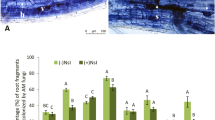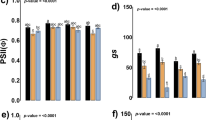Abstract
Capsicum annuum (pepper) plants were inoculated with the arbuscular mycorrhizal (AM) fungi Glomus intraradices Smith and Schenck, an undescribed Glomus sp. (AZ 112) or a mixture of these isolates. Control plants were non-mycorrhizal. Plants were grown for 8 weeks at moderate (20.7–25.4°C) or high (32.1–38°C) temperatures. Colonization of pepper roots by G. intraradices or the Glomus isolate mixture was lower at high than at moderate temperatures, but colonization by Glomus AZ112 was somewhat increased at high temperatures. Pepper shoot and root dry weights and leaf P levels were affected by an interaction between temperature and AM fungal treatments. At moderate temperatures, shoot dry weights of plants colonized by the Glomus isolate mixture or non-AM plants were highest, while root dry weights were highest for non-AM plants. At high temperatures, plants colonized by Glomus AZ112 or the non-AM plants had the lowest shoot and root dry weights. AM plants had generally higher leaf P levels at moderate temperatures and lower P levels at high temperatures than non-AM plants. AM plants also had generally higher specific soil respiration than non-AM plants regardless of temperature treatment. At moderate temperatures, P uptake by all AM plants was enhanced relative to non-AM plants but there was no corresponding enhancement of growth, possibly because less carbon was invested in root growth or root respiratory costs increased. At high temperatures, pepper growth with the G. intraradices isolate and the Glomus isolate mixture was enhanced relative to non-AM controls, despite reduced levels of AM colonization and, therefore, apparently less fungal P transfer to the plant.
Similar content being viewed by others
References
Alexander M (1982) Most probable number method for microbial populations. In: Black CA (ed) Methods of soil analysis. American Society of Agronomy, Madison, Wis, USA, pp 815–820
Augé R (2001) Water relations, drought and vesicular-arbuscular mycorrhizal symbiosis. Mycorrhiza 11:3–42
Bendavid-Val R, Rabinowitch HD, Katan J, Kapulnik Y (1997) Viability of VA-mycorrhizal fungi following soil solarization and fumigation. Plant Soil 195:185–193
Bowen GD (1987) The biology and physiology of infection and its development. In: Safir GR (ed) Ecophysiology of VA mycorrhizal plants. CRC, Boca Raton, Fla, USA, pp 27–70
Davies Jr FT, Potter JR, Linderman RG (1992) Mycorrhiza and repeated drought exposure affect drought resistance and extra-radical hyphae development of pepper plants independent of plant size and nutrient content. J Plant Physiol 139:289–294
Davies Jr FT, Potter JR, Linderman RG (1993) Drought resistance of pepper plants independent of leaf P concentration response in gas exchange and water relations. Plant Physiol 87:45–53
Davies Jr FT, Olalde-Portugal V, Alvarado MJ, Escamilla HM, Ferrera-Cerrato RC, Espinosa JI (2000) Alleviating phosphorus stress of chile ancho pepper (Capsicum annum L. "San Luis") by arbuscular mycorrhizal inoculation. J Hortic Sci Biotechnol 75:655–661
Erickson AN, Markhart AH (2002) Flower developmental stage and organ sensitivity of bell pepper (Capsicum annuum L.) to elevated temperature. Plant Cell Environ 25:123–130
Fidelibus MW, Martin CA, Stutz JC (2001) Geographic isolates of Glomus increase root growth and whole plant transpiration of citrus seedlings grown with high phosphorus. Mycorrhiza 10:231–236
Graham JH, Drouillard DL, Hodge NC (1996) Carbon economy of sour orange in response to different Glomus spp. Tree Physiol 16:1023–1029
Haugen LM, Smith SE (1992) The effect of high temperature and fallow period on infection of mung bean and cashew roots by vesicular-arbuscular mycorrhizal fungus Glomus intraradices. Plant Soil 145:71–80
Kormanik PP, McGraw AC (1982) Quantification of vesicular-arbuscular mycorrhizae in plant roots, In: Schenk NC (ed) Methods and principles of mycorrhizal research. American Phytopathology Society, St. Paul, Minn, USA, pp 37–45
McGonigle TP, Miller MH, Evans DG, Fairchild GL, Swan JA (1990) A new method which gives an objective measure of colonization of roots by vesicular-arbuscular mycorrhizal fungi. New Phytol 115:495–501
Peng S, Eissenstat DM, Graham JH, Williams K, Hodge NC (1993) Growth depression in mycorrhizal citrus at high phosphorus supply. Analysis of carbon cost. Plant Physiol 101:1063–1071
Rylski I, Spigelman M (1982) Effects of different diurnal temperature combinations on fruit set of sweet pepper. Sci Hortic 17:101–106
Schenck NC, Schröeder VN (1974) Temperature responses of Endogone mycorrhiza on soybean roots. Mycologia 66:600–605
Schenck NC, Graham SO, Green NE (1975) Temperature and light effects on contamination and spore germination of vesicular-arbuscular mycorrhizal fungi. Mycologia 67:1189–1192
Udaiyan K, Karthikeyan A, Muthukumar T (1996) Influence of edaphic and climatic factors on dynamics of root colonization and spore density of vesicular-arbuscular mycorrhizal fungi in Acacia farnesiana Willd. and A. planifrons W.et.A. Mycorrhiza 11:65–71
Watanabe FS, Olson SR (1965) Test of an ascorbic method for determining phosphorus in water and sodium bicarbonate extracts from soil. Soil Sci Soc Proc 29:677–678
Welsh DF, Zajicek JM (1993) A model for irrigation scheduling in container-grown nursery crops utilizing management allowed deficit (MAD). J Environ Hortic 11:115–118
Wheeler TR, Crawford PQ, Ellis RH, Porter JR, Vara Prasad PV (2000) Temperature variability and the yield of annual crops. Agric Ecosyst Environ 82:159–167
Author information
Authors and Affiliations
Corresponding author
Rights and permissions
About this article
Cite this article
Martin, C.A., Stutz, J.C. Interactive effects of temperature and arbuscular mycorrhizal fungi on growth, P uptake and root respiration of Capsicum annuum L.. Mycorrhiza 14, 241–244 (2004). https://doi.org/10.1007/s00572-003-0261-6
Received:
Accepted:
Published:
Issue Date:
DOI: https://doi.org/10.1007/s00572-003-0261-6




